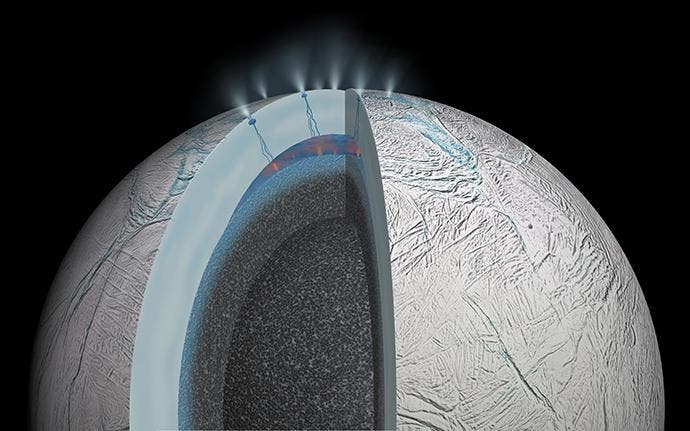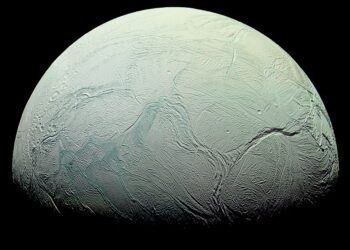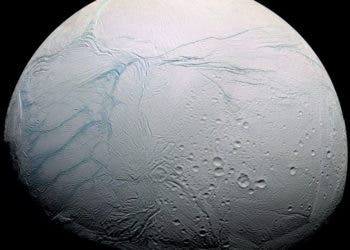When the Cassini-Huygens probe analyzed the salty plumes ejected from Saturn’s moon Enceladus, it found something that made a lot of researchers excited: methane. If Enceladus, an ice-covered moon with a subsurface ocean of liquid water, is hosting methane, it may well be hosting life. Now, a new study seems to add more weight to that idea.

There could possibly maybe be life on Enceladus
The more we look at Enceladus, the more interesting it seems. In 2006, researchers first identified massive water plumes shooting hundreds of miles into space at high speeds. The plumes were also found to be salty, and in order for this to happen, it would mean that the satellite hosts a liquid ocean beneath its frozen surface.
Since then, the Cassini spacecraft dove into these plumes several times, gathering information about their composition. A new study published in Nature Astronomy looked at this chemistry and Enceladus’ ability to potentially host life. The study compared the Enceladus plumes with the deep-sea plumes on Earth, where microbial (and even macroscopic) life is known to thrive.
The chemistry data from Cassini’s mass-spectroscopy measurements show relatively high concentrations of methane, carbon dioxide, carbon monoxide, and organic materials.
“We wanted to know: Could Earth-like microbes that ‘eat’ the dihydrogen and produce methane explain the surprisingly large amount of methane detected by Cassini?” study co-lead author Régis Ferrière, an associate professor in the University of Arizona’s Department of Ecology and Evolutionary Biology, said in a statement.
Ferrière and colleagues built a series of mathematical models that assessed the likelihood of the methane on Enceladus being generated biologically. They also analyzed whether the observed chemistry could sustain a population of Enceladus microbes.
The models determined that hydrothermal vent chemistry fits perfectly with the observations, but only with the presence of methanogenic microbes — and this is good news for our search for extraterrestrial life.
“In summary, not only could we evaluate whether Cassini’s observations are compatible with an environment habitable for life, but we could also make quantitative predictions about observations to be expected, should methanogenesis actually occur at Enceladus’ seafloor,” Ferrière said.

However, the results don’t necessarily mean there’s life on Enceladus — but they do suggest it’s fairly possible. It’s still also possible that geochemical, non-biological processes produced the chemistry observed by Cassini.
What the study tells us is that all that’s needed for life is there, and life on Enceladus is at least a plausible idea. Whether or not life actually is there is a bit more difficult to confirm at this point.
“Obviously, we are not concluding that life exists in Enceladus’ ocean,” Ferrière said. “Rather, we wanted to understand how likely it would be that Enceladus’ hydrothermal vents could be habitable to Earth-like microorganisms. Very likely, the Cassini data tell us, according to our models.
“And biological methanogenesis appears to be compatible with the data. In other words, we can’t discard the ‘life hypothesis’ as highly improbable. To reject the life hypothesis, we need more data from future missions,” he added.

A mission that could dive down to Enceladus’ liquid water is not in sight, and likely won’t be for the next 10-20 years — at least. But that doesn’t mean we can’t indirectly assess its habitability in the meantime, like we’ve been doing until now.
Papers like this one help us not just find life on extraterrestrial bodies but also understand these surprising places in our solar system. After all, an icy moon far away from the Sun is not exactly where you’d expect to find life.
The authors also add that an important advance of the paper is its methodology, which can be applied to other settings as well. In other words, researchers could use the same approach and assess the likelihood of life on planets even outside our solar system.
The study was published in Nature Astronomy.






